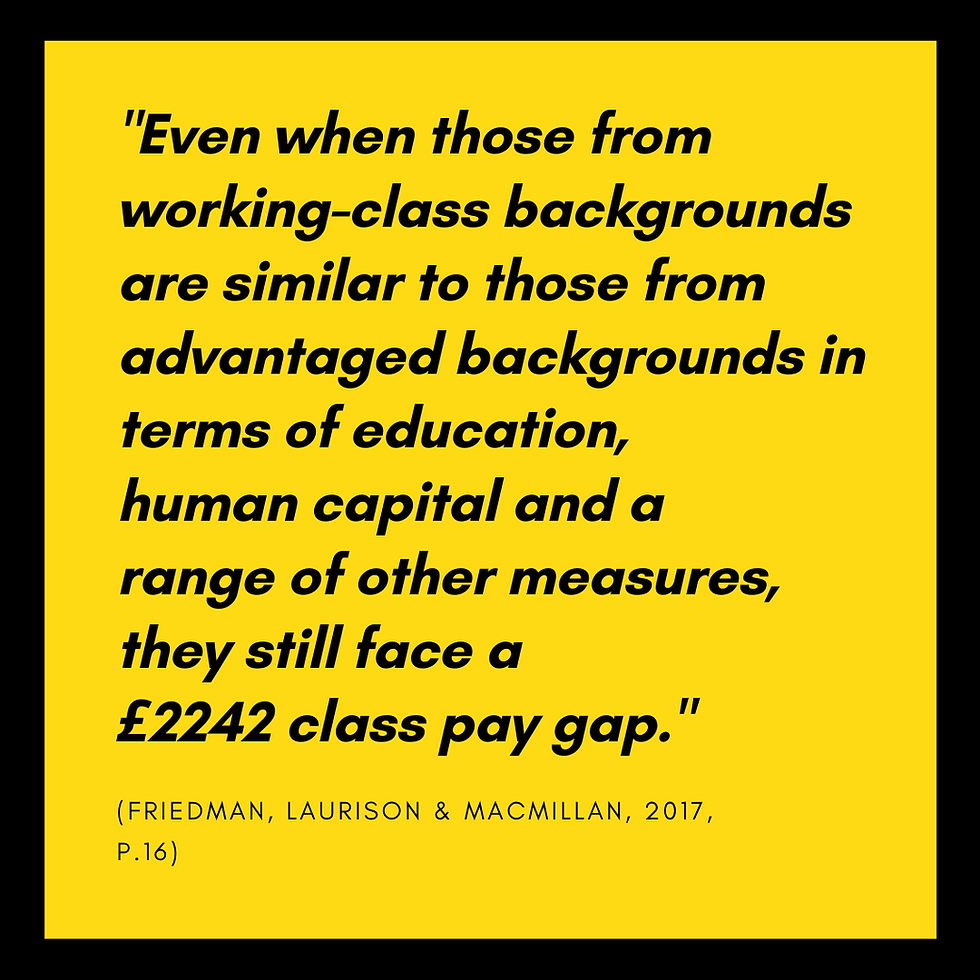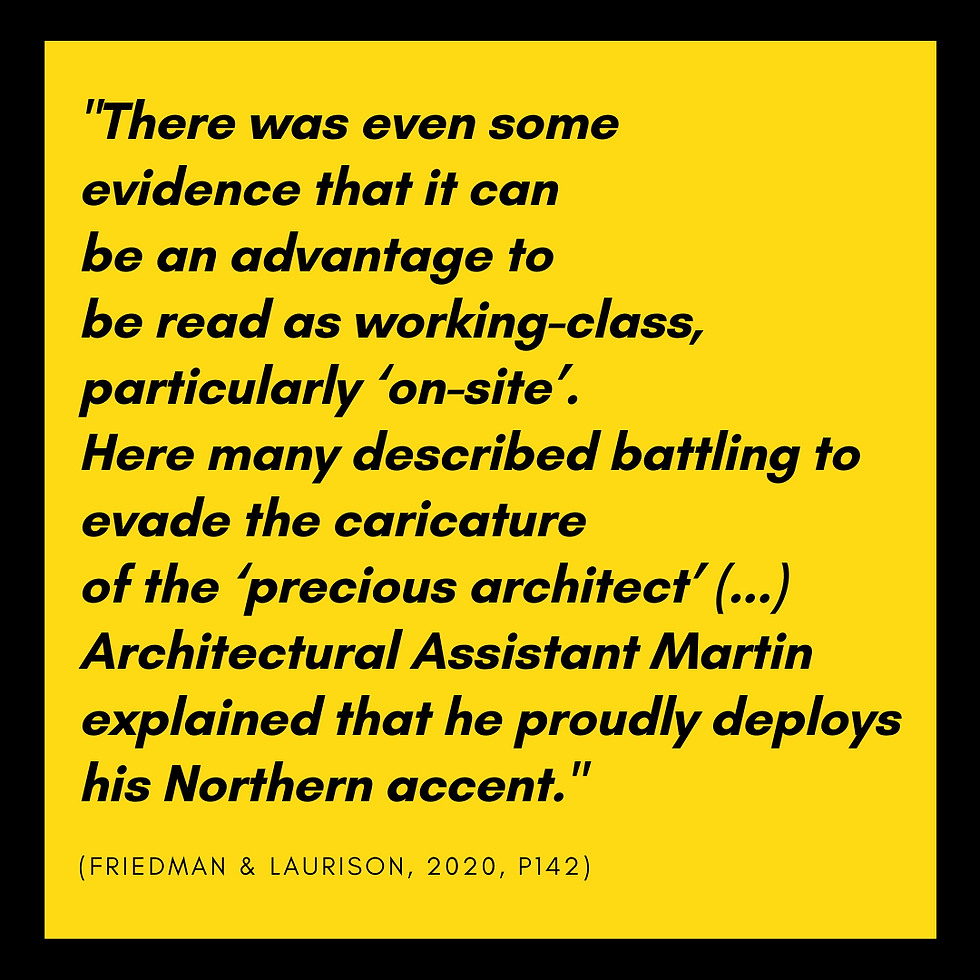Creating a class diverse industry
- Monica Kulkarni
- Dec 6, 2021
- 4 min read
Updated: Dec 8, 2021

Barriers and progression
If we want a more equitable advertising and media industry, we need to understand the barriers working class people face.
Friedman and Laurison (2020) draw on Bourdieu and assert barriers fall into three main categories:
i) Economic capital
ii) Social Capital
iii) Cultural capital
For Jenny Shevlin (2021) it's not just a question of having a network. Here, economic, social and cultural capital deficits collide. Shevlin describes the difficulty of joining the industry without knowing anyone who works in advertising and media. Once you manage to enter the industry, not having enough money to buy rounds of drinks when networking can lead to feeling awkward and inferior. Shevlin explains how these feelings are compounded when you realise you have nothing in common with others. But she doesn’t explain why having little in common behaves like a barrier. After all, according to Gocłowska & Crisp (2014), navigating a different culture can actually be beneficial.
Once working class people manage to enter elite industries, their journey is still hampered. In 2017 the Social Mobility Commission published their class pay gap report, using earnings to indicate how well social classes progress. Drawing on data from the Labour Force Survey, three findings jump out:
Working class employees earn 17% less than colleagues from professional backgrounds
Women and ethnic minorities face a disadvantage double whammy when compared to men from professional backgrounds
In Engineering, IT and public sector professions, the majority do not come from professional backgrounds
We can’t always isolate class from other factors. It combines with other aspects of identity to hamper or aid a person’s progress. We can use a framework known as intersectionality to explain how these factors work together. But surely intersectionality affects progress because it impacts a person before they enter the workforce, right? It impacts their education levels, the ability to move where higher paid jobs are located, the type of organisations they work for, and that’s the reason we see lower representation in these professions.

Well yes, but that’s not the full picture. If we account for the issues impacting individuals early in their journey, working class employees still earn less than their middle class colleagues.
So what on earth is going on here?
Economic capital as the ‘Bank of Mum and Dad’ (Friedman and Laurison, 2020) plays a part - allowing the more advantaged to take risks early in their career or just wait for a better job to come along. Social capital too - knowing someone who can recommend you for a better paid role certainly helps. But it also intersects how the elite value ‘merit’ and the performance of merit. Here, Friedman and Laurison describe merit as “demonstrable skills, qualifications and efforts” (2020, p211). But merit itself doesn’t suffice. “It needs to be seen” (2020, p212) by the right people and it also needs to be performed in the right way.
“This means that particular performances of ‘merit’, especially those that demonstrate a command of classed behaviour codes, have come to shape perceptions of who is appropriate to promote or progress - even though such codes arguably have little connection to the expertise required to do the job effectively.” (ibid)
‘Merit’ sounds a lot like cultural capital, doesn’t it?
Let’s explore how we might solve this issue, and find a way to create a class diverse industry.
Solutions

It’s worth noting Friedman and Laurison (2020) don’t explore the advertising and media industry - the closest they get is television. And with 6TV we discover parallels both in demographics and cultural capital. But what’s interesting is how firms in other traditionally elite sectors overcome the class pay gap. Cooper’s, the architectural firm featured, has no class ceiling. In fact, “around half the Partner group are from intermediate or working-class backgrounds” (Friedman and Laurison, 2020, p.83). We learn an emphasis on technical skills, rather than cultural capital, is why. Technical knowledge is ‘transparent’ with no hidden codes. And intriguingly, when cultural capital does become important, working class habitus becomes an advantage.
Elsewhere, Nik Miller (2020), Lisa Thompson (2020), the Social Mobility Commission (2021) and the IPA (2021), all agree the first step in improving working class entry and progression is measure and monitor. Measuring the proportion of a firm’s workforce by social class, and the representation of different social classes, helps firms understand where they need to focus and whether a ‘class ceiling’ (Friedman and Laurison, 2020) exists.
The same voices also advocate creating an inclusive workplace where “different thinkers feel welcome and bring all of themselves to work.” (Thompson, 2020). For some, this might be formalising sponsorship and mentoring as part of a progression framework (Miller, 2020) and for many, involves some degree of training, awareness-raising and sharing of experiences of different social backgrounds (the Social Mobility Commission, 2021).
But who should do this? Both Miller (2020) and Jacob et al (2020). agree senior management championing and spearheading the cause is only the beginning. Firms need buy-in from across the organisation, particularly given middle management often take responsibility for “enacting and ‘socialising’ dominant work cultures” (Miller, 2020).
In their Toolkit for the Creative Industries, the Social Mobility Commission (2021) promotes searching and recruiting employees by alternative means to a graduate route, such as nurturing mentoring and apprenticeship schemes. And these routes do exist in the advertising and media industry. Brixton Finishing School and SCA 2.0 both offer industry training and entry. BFS offers free, short courses limited to young people aged 18-25 and boasts impressive employment statistics (95% of students go on to work at top tier agencies).
But Thompson (2020) and Amol Rajan (2019) both advise heeding caution here. There is a danger “we bring in those from different social backgrounds and mould everyone to think the same.” (Thompson, 2020). Rajan echoes the same concern and tells a young working class man what he thinks about schemes addressing those soft skills (watch the clip right). After all, it’s when individuals preserve their habitus and learn to adapt to a new culture, do they produce more creative work (Gocłowska & Crisp, 2014).
Clearly, we must strike a balance. It’s not so clear though exactly how agencies implement all these recommendations. With the exception of how to collect socio-economic data (Miller, 2020), we don’t learn of ready and adaptable frameworks for time-pressed companies. And this is why E Corp is so interested in exploring exactly how we can realistically increase working class representation in Adland.



Comments